The Best DAST Tools to Use in 2025
Discover the top DAST tools for 2025 to secure your applications. Explore the best dynamic application security testing solutions for identifying vulnerabilities and ensuring robust protection.

Kruti
Dec 7, 2024
In 2025, DAST tools have become prominent in the current cybersecurity landscape due to the increasing complexity of web applications, including microservices, single-page apps, and APIs. A DAST tool detects security weaknesses in applications while they are running. It effectively identifies possible security issues at runtime by interacting with the application. DAST scanning tools function as black-box testing solutions, requiring no access to source code, which makes them compatible with multiple web application security frameworks and various programming languages.
This blog explores various best DAST tools, their importance, key features, and pricing.
What are DAST Tools?
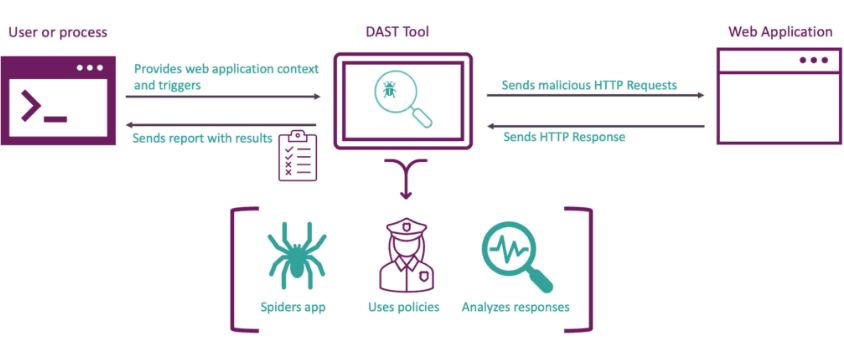
Dynamic Application Security Testing tools are essential for identifying security vulnerabilities in web applications and APIs while they are actively running. These tools mimic actual attacks to identify possible vulnerabilities, such as SQL injection (SQLi) and Cross-Site Scripting (XSS), that harmful entities could target.
DAST testing tools begin by automatically crawling the web application. In this process, they inject different forms of input, such as specific characters or scripts in forms, simulating an attacker's behavior when exploiting vulnerabilities.
DAST security tools identify weak points in web applications based on attack simulations and traffic analysis, which include poor coding practices, configuration errors, or logical faults that attackers could exploit.
Why do Organizations need DAST Tools?
Here are some of the reasons why security teams should adopt Dynamic Application Security Testing tools in their web application testing:
Identifies security vulnerabilities in web applications
DAST security tools function as advanced scanning assistants that detect how hackers could exploit to access web applications. Threat modeling helps organizations address security flaws and remove vulnerabilities proactively.
Mitigates security breach risks
Given the prevalence of web application attacks, organizations should utilize Dynamic Application Security Testing tools to mitigate the risk of attacks by addressing vulnerabilities that DAST identifies. By doing so, organizations can protect information and maintain customer and stakeholder trust.
Improves DevSecOps integration
This integration will enable application security engineers to incorporate DAST tools into the pipeline, facilitating continuous testing and vulnerability detection during the development phase. This approach reduces remediation costs and ensures the safe deployment of web applications.
Ensures compliance with security standards
Many industries require adherence to strict security regulations, such as GDPR, HIPAA, and PCI DSS. DAST security tools help organizations meet these requirements by identifying compliance gaps and providing actionable insights to address them effectively.
Simulates realistic attacks
Dynamic Application Security Testing tools mimic real-world scenarios of how attackers may find and exploit vulnerabilities in web applications. This simulation is essential in identifying possible attack paths and determining effective remediation measures.
How to Choose the Best DAST Tool for Your Needs
Choosing the best DAST security tools is important for improving application security and solving problems effectively. Understanding important factors such as compatibility, scalability, and integration can help security engineers make informed decisions that match the objectives of their organization. Here's a breakdown of some of the considerations to choose the right dynamic application security testing tools:
Understand the application environment.
When selecting a DAST tool, ensure that it is compatible with the technologies and frameworks used by the security team involved, whether APIs, web applications, or microservices. A tool that works under the required conditions ensures thoroughness and accuracy in vulnerability scans.
Evaluate scalability
An effective Dynamic Application Security Testing (DAST) tool must be able to withstand the growing needs and load of applications. It should retain performance and accuracy even when the number of apps or the complexity of environments grows.
Check integration capabilities
The tool should interact seamlessly with existing security and development workflows, such as CI/CD pipelines and version control systems. This makes it possible to include vulnerability detection throughout the entire development lifecycle.
Concentrate on ease of use.
Security teams must use an intuitive interface to effectively manage vulnerabilities, making a DAST solution easier to configure for scans, results analysis, and actionable reporting that helps security engineers respond more quickly.
Evaluate reporting features
Reporting features are crucial when selecting the ideal Dynamic Application Security Testing tool. Security teams require detailed reports that categorize issues by severity and provide clear solutions to prioritize and effectively address essential concerns.
Top 10 Dynamic Application Security Testing (DAST) Tools in 2025
Here's a breakdown of some of the Top 10 Best DAST tools:
1. Akto.io
Akto is an AI-powered API security platform that provides comprehensive security test capabilities, including the best DAST testing features. It effectively integrates with any development pipeline. It ensures that the development process identifies security weaknesses with a seamless code-to-runtime approach.
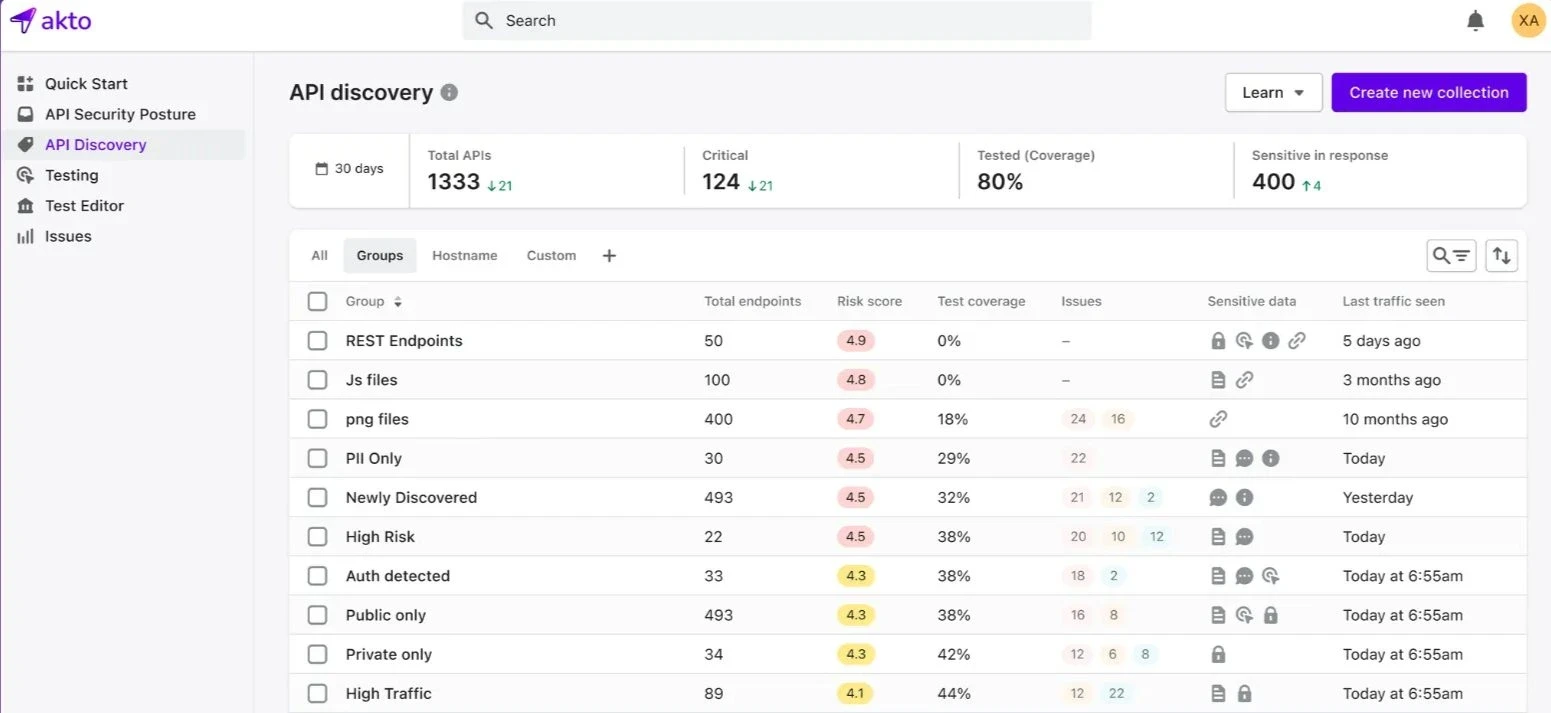
Features of Akto DAST Testing:
Contextual Traffic-Driven Scanning: Akto uses current or historical API traffic (REST, GraphQL, gRPC, SOAP) to simulate real-world behavior and identify undocumented "shadow APIs."
CI/CD Integration: Easily integrates with pipelines, facilitating pre-deployment scanning, pull request checks, registration tests, and release blocking on critical vulnerabilities.
Runtime Vulnerability Detection: Beyond the pre-production Akto constantly monitors runtime traffic to detect live threats and deliver clear prioritized remediation reports.
Massive Test Library: It includes over 1,000 security tests and also comprises OWASP API Top 10 vulnerabilities, such as authentication flaws, business logic flaws, XSS, CSRF, and assists in custom rule creation through YAML templates.
AI Agents: AI-Powered agents scan for over 100 sensitive data types (PII, PHI, Tokens) and support custom definitions that complies with GDPR, HIPAA, and PCI-DSS.
Ideal For:
DevSecOps teams, engineering teams, and enterprises seeking DAST tools for their CI/CD pipelines and aiming to automate API testing before deployment.
2. Burp Suite
Burp Suite boasts dominant features in its DAST solutions, including powerful scanning capabilities, extensive customization options, and robust vulnerability detection. Most security engineers rely on this tool for interactive scanning, which includes manual testing capabilities for exploiting security flaws.
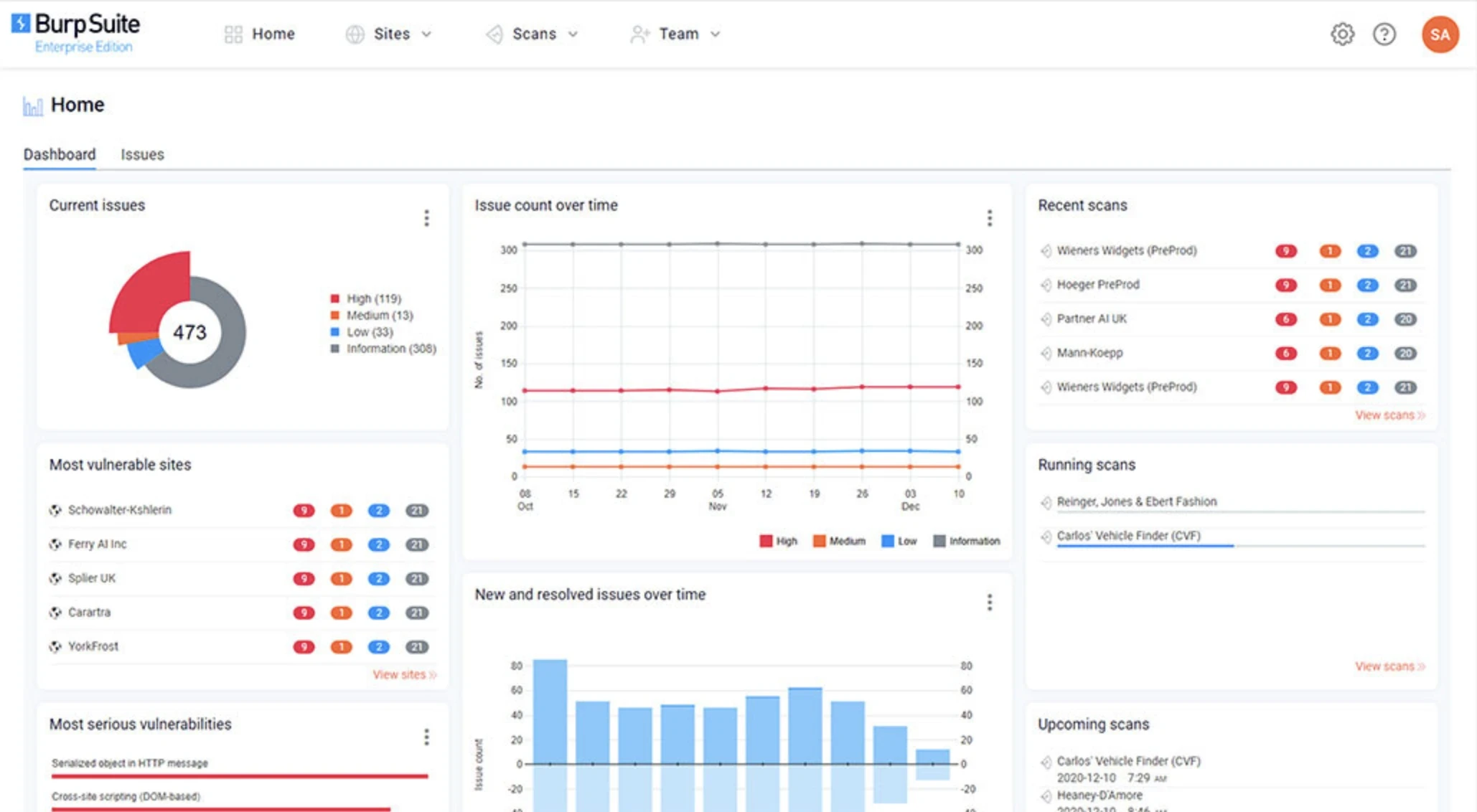
Image Source: Burp Suite
Features of Burp DAST Solution:
Dynamic Scanner: The Dynamic Scanner conducts thorough crawling and automated auditing to identify a broad range of vulnerabilities.
API Scanning: It adopts a Chromium browser to scan and crawl modern SPAs, API definitions (OpenAPI, Postman, SOAP, GraphQL), and privileged areas through recorded authentication flows.
Scalable and CI/CD-driven scanning: Schedule recurring scans, manage batches through bulk actions, perform scans from CI/CD pipelines, and trigger alerts or builds based on scan outcomes.
Custom configurations: Burf also offers granular scan tuning, full support for BApp extensions, and custom BChecks, along with browser-based authentication uploads.
Dev Team Integration and Reporting: It features graphical dashboards, customizable HTML reports, issue tracking integrations, GraphQL API access, and remediation guidance.
Ideal For:
It is ideal for AppSec and VM teams, DevSecOps teams, and business organizations that seek extensibility.
3. OWASP ZAP
OWASP ZAP excels in providing users with an easily understandable interface, continuous updates, and a large number of plugins, as well as DAST solutions that expand security test functionality. Additionally, it can perform both automated and manual scans for security purposes.
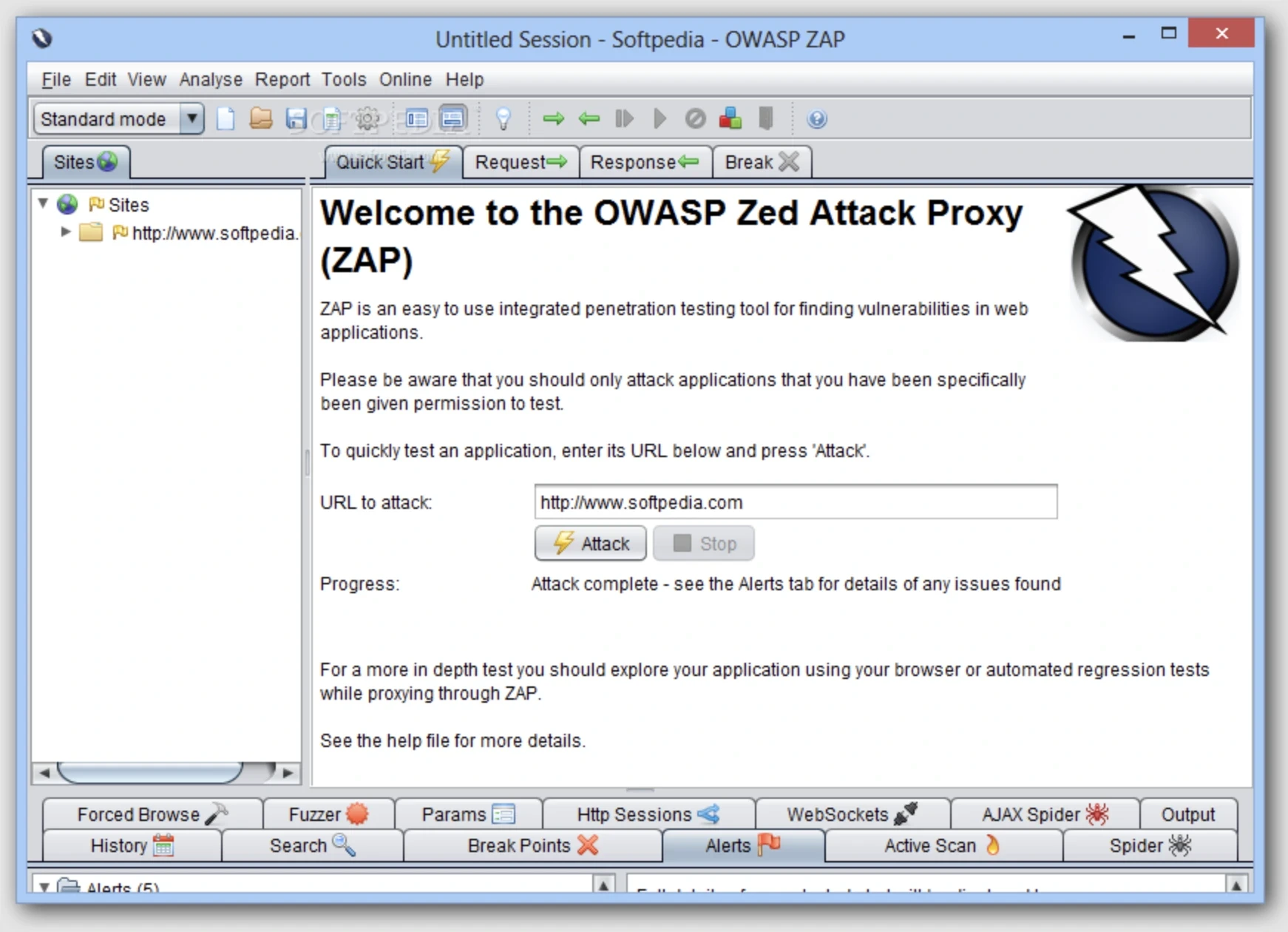
Image Source: OWASP ZAP
Features of OWASP DAST Scanning:
Intercepting Proxy with Automation and Manual Control: It functions as a proxy, allowing users to intercept, inspect, modify, and replay HTTP(S) traffic.
Spider Ajax and Spider: It has both traditional and AJAX-based crawlers to explore web applications, which include JavaScript-rich SPAs and populate site maps for comprehensive scanning.
Scanning Engines: Combines passive analysis and active probing to detect a wide variety of security issues in real-time.
Fuzzer and WebSocket Testing: Supports custom fuzzing to test input handling and strong WebSocket tampering for real-time app protocols.
Scripting and Marketplace Extensibility: Provides scripting support and an add-on marketplace to extend scanning logic, authentication strategies, compliance checks, etc.
Ideal For:
Penetration testers and AppSec teams who need powerful, versatile proxy for both manual exploration and automated scanning.
4. Veracode
Veracode is a cloud-based platform with deep scanning capabilities, a DAST scanning tool, and detailed reporting features to help security teams identify and fix vulnerabilities. It also integrates well with various development tools, giving real-time feedback and ensuring continuous security assessment.

Image Source: Veracode
Features of Veracode DAST Security:
Fast Onboarding and Setup: Users can configure and perform scans on web apps or APIs in just a few clicks, which facilitates a quick security testing ramp-up.
Cloud Native Scanning: It is supported by a cloud-native engine that conducts hundreds of simultaneous scans, including internal apps behind firewalls.
Low false positives: The platform provides accurate results, with findings appearing in just minutes, which helps teams prioritize and remediate efficiently.
Customizable Scan Control: Offers fine-grained control over scan depth, speed, invasiveness, authentication methods and crawl scripting.
CI/CD & DevOps Integrations: It integrates into automated pipelines through REST API, CLI, and scripts, allowing for shift-left security, scheduling, and bulk scan workflows.
Ideal For:
DevSecOps teams, enterprises with large or complex portfolios, and organizations that need deep scan control.
5. Invicti
Invicti is a DAST-first AppSec platform that features automation, an advanced scanning engine, and integration with CI/CD pipelines to provide accurate detection of security weaknesses. Security teams can focus on real security threats by using the proof-based scanning approach to reduce false positives.
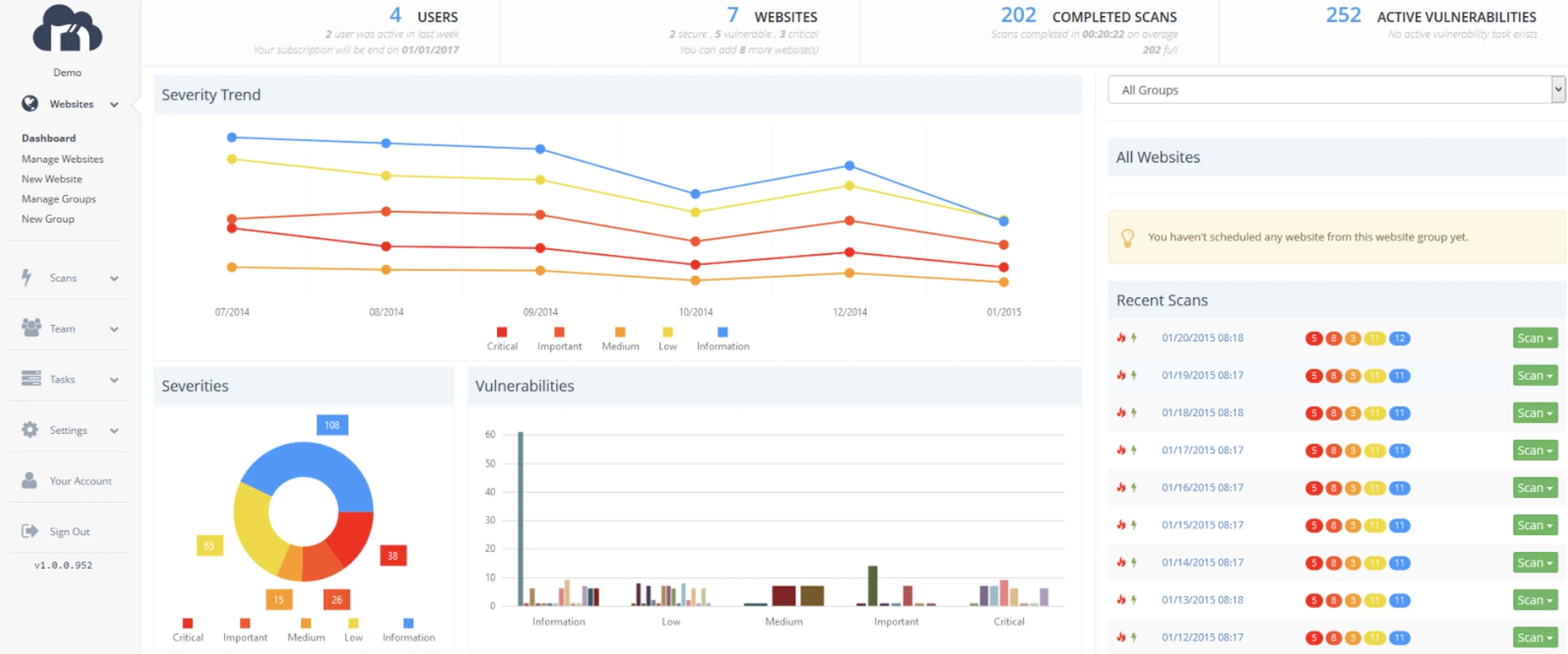
Image Source: Netsparker
Features of the Invicti DAST Tool:
Proof-based scanning: Automatically confirms vulnerabilities with high accuracy, dramatically reducing false positives and allowing faster remediation.
Cloud-native, Scalable scanning: It supports fast, parallel scans of web apps and APIs with firewalls, as well as flexible scheduling for DevSecOps pipelines.
Quick setup & Easy onboarding: Enables users to perform web and API scans through intuitive configurations.
Authenticated crawl and Scan Control: Offers granular control over crawl depth, scan speed, authentication methods, API definition imports, and SPA support.
CI/CD integration: Easily integrates via REST API and CLI for automatic scanning in pipelines, allowing for shift-left security and scans.
Ideal For:
API first teams, large enterprises, DevSecOps teams, and security teams seeking DAST Solutions.
6. Acunetix
Acunetix is a comprehensive DAST tool, offering advanced scanning algorithms, interactive reporting, and easy integration with development workflows. It provides precise, detailed, and actionable insights to advance application security.

Image Source: Acunetix
Features of the Acunetix DAST Tool:
DeepScan Crawler with Modern Browser Emulation: Automatically navigates tough JavaScript-heavy SPAs, managing JSON/XML inputs, SOAP, REST APIs and Multilevel forms.
Login Sequence Recorder for Authenticated Scanning: Records multi-step flows and replays them during scans to ensure proper scanning of authenticated areas.
AcuSensor Integration: It has sensors in Node.js, PHP, Java or ASP.NET apps to gain backend visibility discover hidden files and inputs, capture flaws and trace issues early.
AcuMonitor and Blind Vulnerabilities: Detects advanced issues, such as blind XSS, XXE, SSRF, and email header injection, through OAST notifications that standard scanning can't reach.
Proof-Based Scanning: Identifies over 7,000 vulnerability types, including OOB SQL injection, DOM-based XSS, SSRF, and email header injection, which provides confirmed exploit proof to reduce false positives.
Ideal For:
QA teams, DevSecOps teams, AppSec and Penetration Testing teams and security teams that are looking to track advanced threats.
7. AppSpider
AppSpider is a DAST tool. It features dynamic scan capabilities, interactive testing functionalities, DAST security tools, and detailed reporting, all of which are helpful to security engineers in addressing security issues according to their specific needs. It also offers multi-audit method authentication for some applications that the security engineers test accordingly.
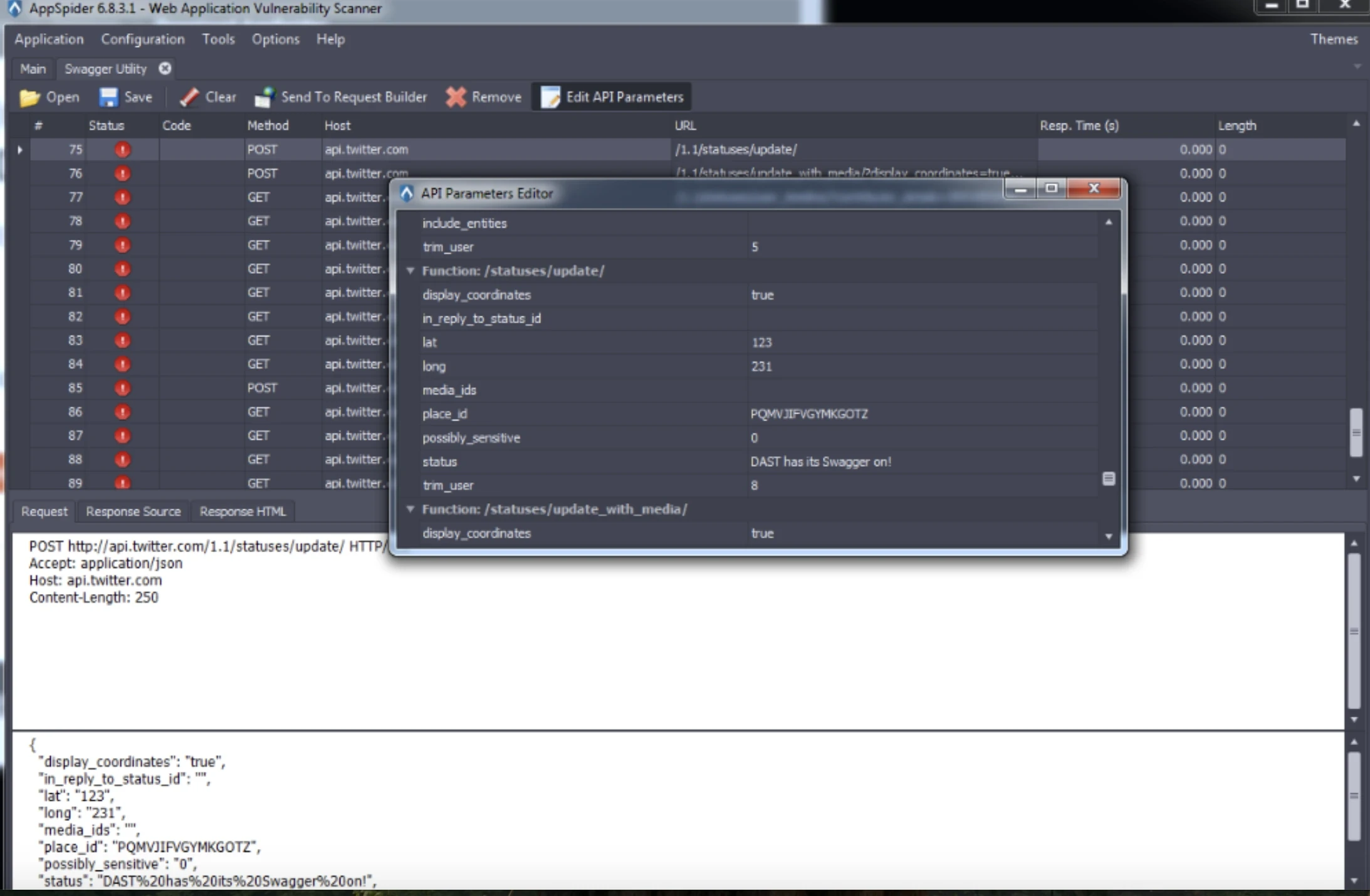
Image Source: App Spider
Features of AppSpider DAST Tool:
Universal Translator Crawler: Automatically crawls and parses modern web technologies and traditional web apps to ensure deep, contextual mapping of UIs and endpoints.
Advanced support: Manages complex workflows that include mobile backend API testing via recorded traffic and proxy replay.
API & Mobile Backend Testing: Supports end-to-end scans of RESTful APIs used by mobile apps, with options to import recorded traffic for targeted API security testing.
Enterprise deployment & Centralized control: It also manages multiple scan engines, allowing for distributed, scheduled, and version-tracked DAST across various applications.
WAF Virtual Patching Integrations: The defense module can generate vulnerability-specific WAF/IPS rules and automate mitigation at an early stage.
Ideal for:
Large enterprises are looking for temporary security solutions while developers enforce fixes.
8. HCL AppScan
HCL AppScan offers robust scanning capabilities, seamless integrations with various development tools, and comprehensive reporting features. It includes automated scanning, a DAST security tool, vulnerability management, detailed reporting, and integration with several popular development tools. HCL AppScan supports multiple languages and frameworks, allowing for an application environment of any diversification.
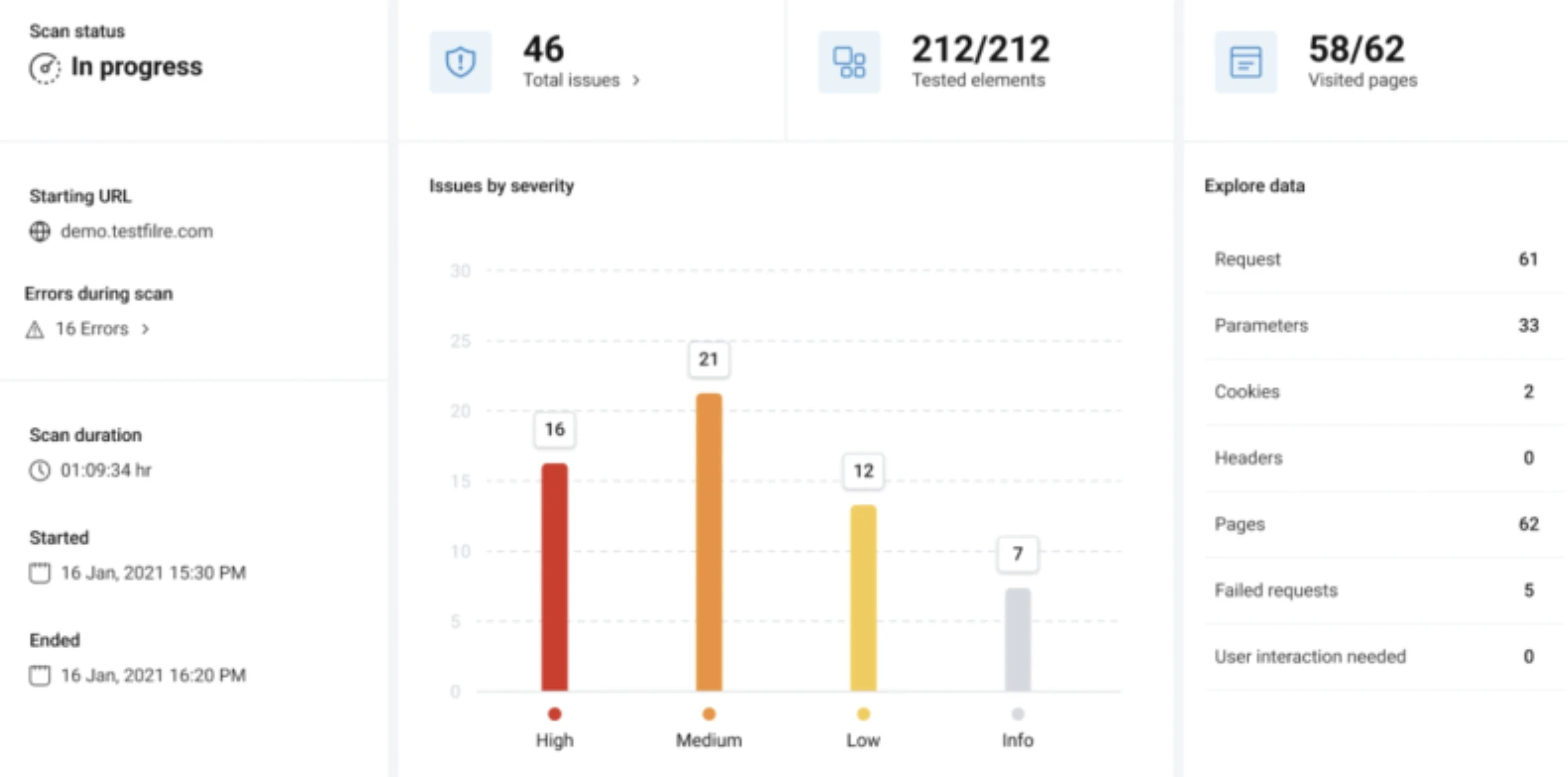
Image Source: HCL AppScan
Features of AppScan DAST Tool:
Universal Crawler: Uses browsers and proxies to crawl and discover modern web apps, SPAs, APIs and mobile backends—Automate deep scanning with multi-step logic support.
Optimized Scanning: Enables selective scans on new code using the "Test Optimization Slider," offering different speed and accuracy modes.
Intelligent Finding Analytics: AI/ML-assisted error detection minimizes false positives and optimizes scan operations.
Sequence Recording: Records and replays login flows, which include MFA, SSO, one-time passwords using an activity or traffic recorder.
Component Scanning: Scans web API and detects vulnerable third-party libraries and server-side misconfigurations.
Ideal for:
DevOps, Penetration testers, Security engineers and enterprises seeking modern dynamic application security testing.
9. WebInspect
Fortify webInspect is one of the popular DAST tools. It is known for its scanning engine's depth, detailed vulnerability report, and seamless integration into the security operations center. The application supports a wide variety of technologies and frameworks that could be used in enterprise-level security testing.
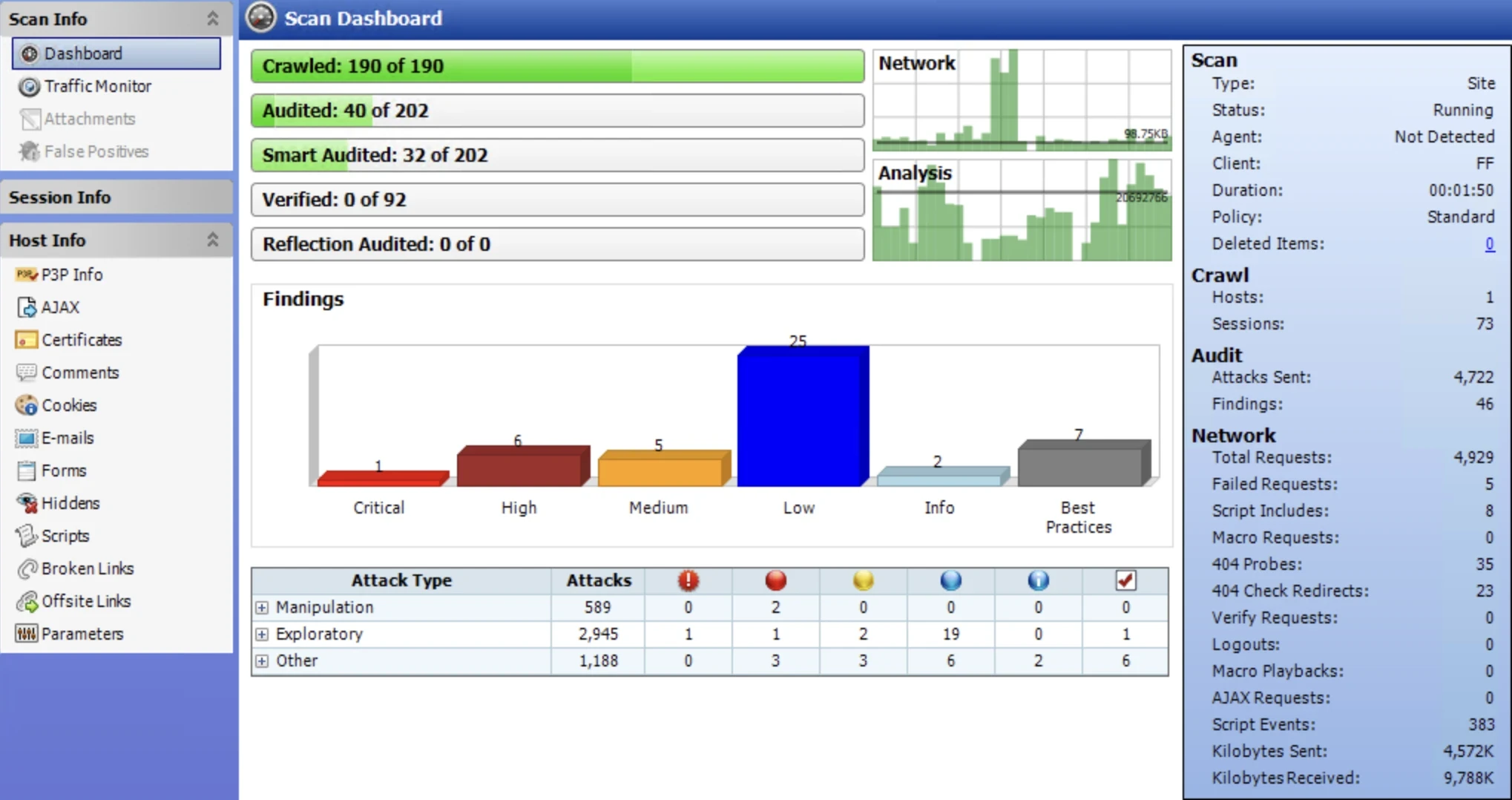
Image Source: WebInspect
Features of Fortify WebInspect DAST Tool:
Crawler with Macro Recorder: It utilizes embedded browsers and session-based macros to explore modern SPAs and multi-step workflows properly.
Policy-based attack checks: Ships with configurable policies that consist of thousands of attack checks to ensure scans cover the latest vulnerabilities.
CLI & docker headless scanning: Compatible with headless execution through CLI or Docker images for integration in CI/CD pipelines.
Enterprise integration & centralized management: Connects with Fortify Security Center to manage distributed sensor, retesting, and scan tracking.
Traffic Viewer & Retesting Tools: Offers tools for inspecting scan traffic, customizing check inputs and retesting vulnerabilities with built-in status tracking.
Ideal for:
Security Analysts, enterprise security teams, vulnerability management teams, and DevSecOps seeking detailed analysis, validation, and remediation tracking of issues.
10. Qualys WAS
Qualys web application scanning offers a cloud-based platform, broad scanning capabilities, and extensive reporting, enabling organizations to better identify and mitigate risks. Real-time alerts accompany continuous monitoring to help a company manage its security proactively.
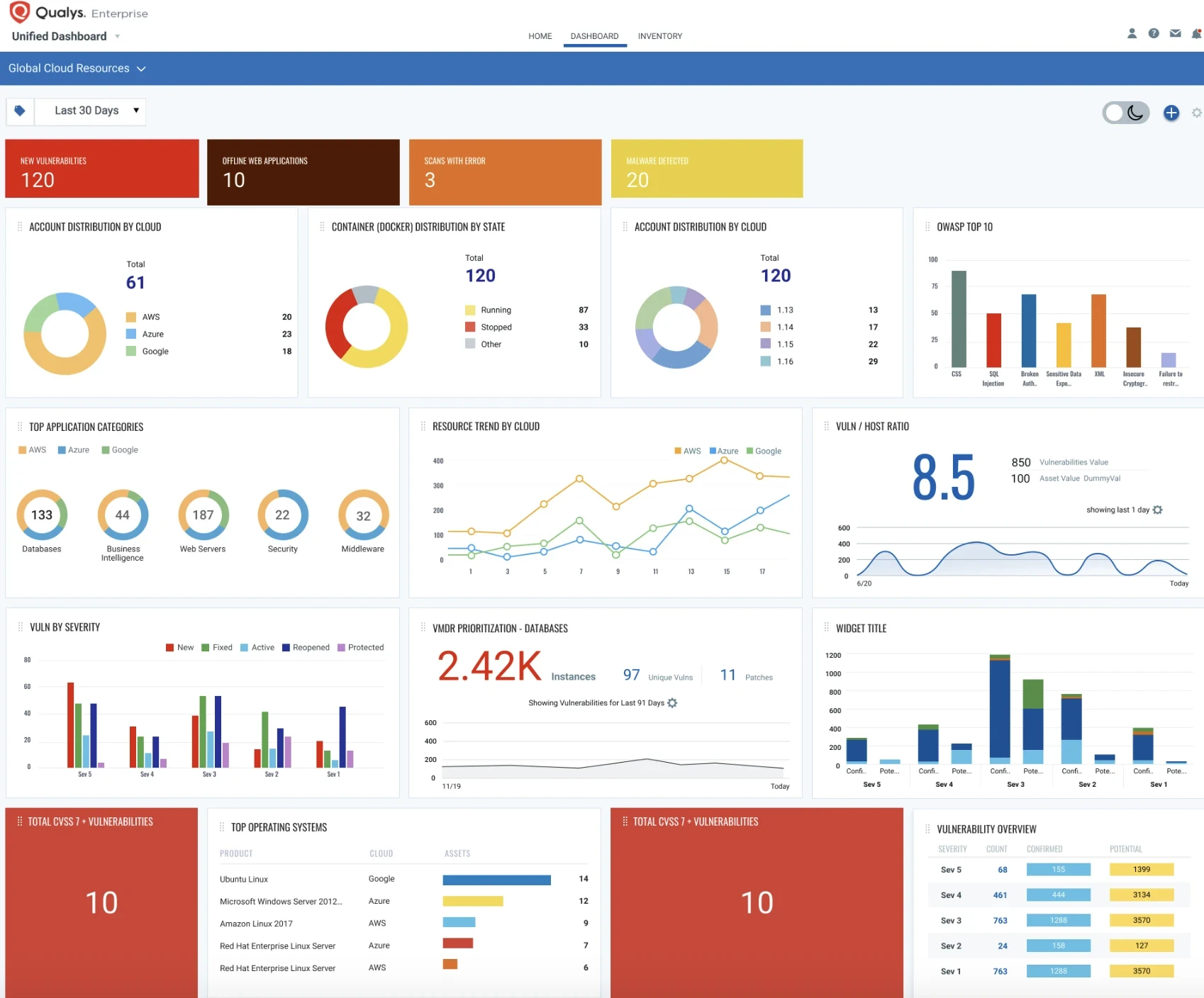
Image Source: Qualys WAS
Features of Qualys DAST Tool:
Web and API Scanning: Scans web applications and APIs with a fully cloud-based engine, supporting large-scale deployment without on-premises overhead.
Discovery of Shadow APIs: Automatically detects all web assets like unauthorized, undocumented APIs and subdomains.
AI-Driven Scanning: AI-powered clustering to reduce scan time by 80% and achieve 96% detection and has risk scoring for risk-based prioritization.
Exposure and Malware Detection: Identifies data leaks, OWASP Top 10 risks, API spec deviations and other threats.
CI/CD Integrations & ITSM Workloads: Supports easy integrations into pipelines and ITSM tools, which allows shift-left and shift-right practices.
Ideal for:
MSPs, Large enterprises, API first teams and DevSecOps pipelines who are looking to achieve modern secure application environments.
Final Thoughts
Utilizing the DAST technologies will ensure the application security. The solutions listed above can solve a wide range of security challenges, from web apps and APIs to enterprise-level applications. These Dynamic Application Security Testing (DAST) tools meet a variety of organizational demands, including real-time scanning, easy integration, and in-depth vulnerability research.
API Security Platform distinguishes itself in API-driven applications with real-time vulnerability detection and smooth integration into DevSecOps workflows. Akto's approach to API security ensures that it constantly secures applications against potential attacks, making it an excellent solution for modern organizations seeking to enhance their security posture. Besides this, Akto also has MCP Security Platform, which is designed to protect Model Context Protocol servers with its capabilities like MCP server discovery, full endpoint visibility, live threat detection, real-time monitoring, deep vulnerability testing and more.
Looking to implement API Security or MCP Security for your AppSec teams? Contact us and book a API Security demo to learn more about Akto.
Related Links
Experience enterprise-grade Agentic Security solution
